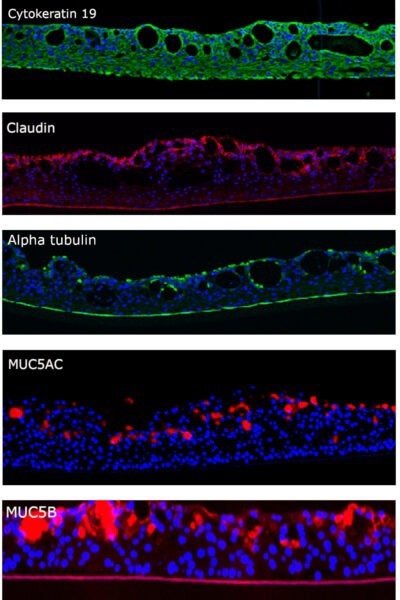Overview
The human 3D in vitro nasal tissue model from MatTek has been redefining preclinical testing in the field of toxicology, inflammation, viral research, and permeation.
EpiNasal is a user-friendly, 3D tissue model cultured that has been cultured with the help of normal, human-derived nasal epithelial cells to offer scientists a human-relevant, in vitro nasal system.
EpiNasal reiterates the in vivo mucociliary phenotype and its barrier, and infection and toxicity answers parallel those of native tissue. Having been cultured at the air-liquid interface, EpiNasal enables physiological exposures to chemicals, therapeutics, and pathogens.
EpiNasal includes primary human nasal epithelial cells that are differentiated to develop a user-friendly 3D model exhibiting remarkable characteristics.
Features
- Mucociliary differentiation
- Delivered ready-to-use
- Mucin-producing goblet cells
Technology

Image Credit: MatTek
EpiNasal displays cellular morphology and human-relevant tissue structure with high evenness and reproducibility. Its 3D structure comprises CK19+ epithelial cells, functional tight junctions (Claudin), beating cilia (alpha-tubulin), mucus-producing goblet cells (MUC5AC, MUC5B), and the SARS-CoV-2 entry-related virus receptors (ACE-2, TMPRSS2)

Image Credit: MatTek

Image Credit: MatTek
Applications
The EpiNasal 3D human tissue model has been used for a range of applications such as the study of respiratory syncytial virus infections, anti-viral research, intranasal drug delivery, the high release of matrix metalloproteases in response to viral infections, and safety & risk assessment (nasal irritation of inhaled therapeutics).
Briefly, the 3D nasal tissue model along with a polarized and multilayer tissue structure will act as a useful tool to forecast the safety of therapeutic candidates, chemical inhalants, and bacterial and viral infections. The protocols enable researchers to achieve data in just days, not weeks or months.
Viral infection
Make use of EpiNasal to study respiratory replication, viral attachment, and innate immune responses and for anti-viral drug development.
Permeation
EpiNasal’s cell culture insert format enables instant determination of API permeation and flux.
Inhalation toxicology
Utilize EpiNasal to identify the comparative safety of nasal sprays and intranasal drug formulations with the help of the TEER and MTT assays and inflammatory responses.